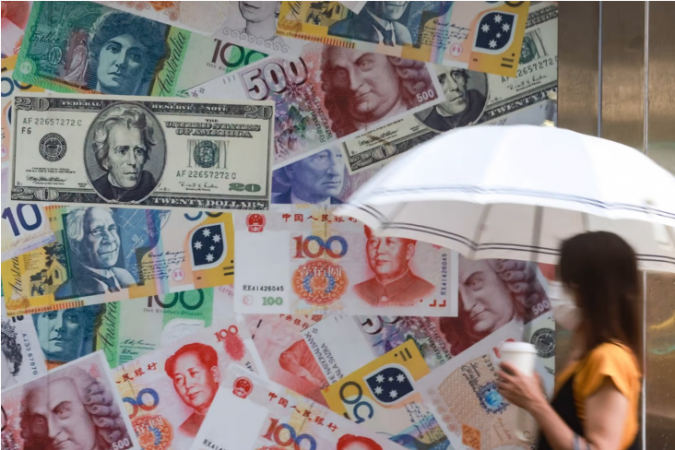
BEIJING: Despite the fact that the yuan fell to a two-year low against the US dollar on Monday, other Asian currencies have fallen more dramatically, analysts say. This could increase financial risks in the region and reduce China's export competitiveness.
Following a scathing remark by US Federal Reserve Chairman Jerome Powell at the Jackson Hole summit last Friday, the Chinese currency on Monday crossed the USD 6.9 level for the first time since August 2020.
The yuan has fallen nearly 2,000 basis points against the dollar as the People's Bank of China unexpectedly cut two key interest rates on August 15 and then cut another pair of lending rates last week.
Policymakers in China are increasingly moving away from those in the US, which were tightening the money supply to fight inflation.
The onshore yuan exchange rate rose 230 pip points from Tuesday's previous close of 6.8980. The smallest unit of currency in dollar terms is called a pip, which is equal to one hundredth. Onshore yuan exchange rates are allowed to move 2% either way from the daily reference rate.
Compared to other important currencies in the Asia-Pacific, the yuan's decline is minimal.
On Monday, the Korean won fell to its lowest level against the dollar since April 2009, when the world financial crisis was at its peak.
According to a report by the Institute of International Finance, foreign investors continued to reduce their holdings of Chinese bonds in July, selling nearly US$3 billion, as well as hitting US$3.5 billion for the first time in China's stock market. Outflow was experienced. Months (IIF).
According to Katrina L, senior economist at Moody's Analytics, pressure on emerging market currencies in Asia increased after Powell's pledge to fight inflation. The dollar usually strengthens when rates are raised.
According to the analyst, a wider interest rate differential between the US and Asia is a possibility, which will likely keep Asian currencies under pressure. Since the risks of a global recession are also uncomfortably high, risk aversion was also a factor.
According to Yuting Shao, a macro strategist at State Street Global Markets, weakening Asian currencies will increase the amount of pass-through for imported inflation, fuel risks associated with capital flight and force central banks in the region to conduct a delicate strike. Will be done. A balance between raising rates without jeopardizing economic growth.
Other important currencies, including the yen and the euro, declined as the dollar strengthened, but according to Wei Hongxu, a researcher at non-partisan international think tank Enbound, the yuan's decline has been far less pronounced.
This has eased the dollar's pressure on the yuan, he said.
He said a devaluation of the yuan could help China's exports, but could also cause volatility in the country's capital markets.
According to analysts at China International Capital Corporation, the beneficial effect of the weakening yuan on China's exports has waned since 2017, owing to trade tensions with the US and the COVID-19 pandemic (CICC).
Even if we agree with the argument that a devaluation would increase exports, he wrote in a note on Tuesday, "we need to look at the extent of depreciation in other economies, that is, whether the so-called competitive is devalued."
According to the CICC, since the pandemic began, Chinese-made goods have become more expensive than those produced by rival countries, and the yuan is now stronger than the currencies of many other important export-oriented economies.
According to analysts, in the future, this could hurt China's ability to compete at the expense of exports, especially in light of the recent significant exchange rate depreciation in other major exporting countries.
According to Wind, a Chinese provider of financial data, the won has fallen more than 13% against the dollar since the beginning of the year, while the yen and baht have declined 20% and 9.8%, respectively.
However, the Vietnamese dong has decreased by only 0.3% since the beginning of 2022.
The yuan is down about 8.6%. Even the euro has lost more by around 12 per cent.
According to experts, a sharp fall in the value of the yen during the first half of the year could force more export-oriented economies to devalue their currencies to maintain export competitiveness. On Monday, the yen's value hit a 24-year record low in mid-July.
"East Asia needs to address the potential ripple effects of a 'competitive devaluation' of the Japanese yen, which could disrupt regional trade and investment," Wei said.
However, given the divergent positions of China, South Korea, Japan and Southeast Asia in supply and industrial chains, the risks associated with the trade were probably limited.
He claimed that there are existing areas of capital inflow and investment. The depreciation of the South Korean won and the Japanese yen, among other currencies, could worsen capital flows into the Asia-Pacific region.
UN chief for aid pushes for resumption of development assistance for Afghanistan
India will gain as a destination for investment as China slows: SBI
How Covid-19 is causing a crisis in unemployment